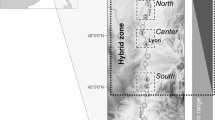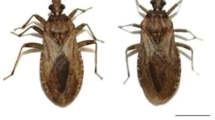Abstract
A population of lady-bird beetles at the head of the Crowsnest River valley on the immediate east side of the Rocky Mountains has been sampled regularly over the years 1961 to 1964. The 389 individuals studied had chromosome numbers ranging from 2n = 14 (58%) to 2n = 20 (3%). The former is the diploid number of C. hexacyclus, the latter that of C. tricyclus, species otherwise known respectively only in the Prairie Provinces and the interior of British Columbia plus the adjoining part of the State of Washington. About 19% of the beetles had the intermediate number of 17 chromosomes, males possessing either a hexacyclus-type or a morphologically distinct tricyclus-type Y chromosome. — In all numerical categories meiotic pairing was virtually perfect but the trivalents in heterozygotes were frequently linearly aligned. This assures production of aneuploid (duplicationdeficiency) gametes, only complementary recombinations of which are viable. Segregational sterility resulting from triple (92%), double (84%) and single (50%) heterozygotes is estimated to be ca 40%. Of four neo-diploids, with zero chromosomal sterility, predicted in the F2 only one materialized with certainty, the one with 13 + tricyclus-type Y. This is interpreted to mean that F2 progeny are rare; rare because (1) random mating, complete introgression, is the rule and (2) Segregational sterility is severest in triple heterozygotes. — Despite the population-depressing effect of the inviable aneuploid zygotes, it is calculated that segregation and crossing-over generate a minimum of 148 × 109 new recombinants (a minimum were crossing-over strictly localized); those acquiring beneficial attributes will be favoured by natural selection. — Topographically, it is evident that tricyclus adults invade the resident hexacyclus community year after year, borne on the prevailing westerly winds that funnel through Crowsnest Pass (elevation only 4463′): hexacyclus is thereby constrained to the east of the Continental Divide and consequently does not penetrate into tricyclus territory.
Similar content being viewed by others
References
Callan, H. G., and P. A. Jacobs: The meiotic process in Mantis religiosa L. males. J. Genet. 55, 200–217 (1957).
Hughes-Schrader, S.: Polarization, kinetochore movements, and bivalent structure in the meiosis of male mantids. Biol. Bull. 85, 265–300 (1943).
Inamdar, N. B.: A note on the reorientation within the spindle of the sex trivalent in a mantid. Biol. Bull. 97, 300–301 (1949).
John, B., and K. R. Lewis: Studies on Periplaneta americana II. Interchange heterozygosity in isolated populations. Heredity 11, 11–22 (1957).
Lewis, K. R., and B. John: Chromosome marker. London: J. & A. Churchill Ltd. 1963.
Smith, S. G.: The cytogenetic basis of speciation in Coleoptera. Proc. Intern. Congr. Genet., 10th Meeting, Montreal, Canada, p. 444–450, 1959; - Cytogenetics of insects. Ann. Rev. Entomol. 5, 69–84 (1960); - Tempero-spatial sequentiality of chromosomal polymorphism in Chilocorus stigma Say (Coleoptera: Coccinellidae). Nature (Lond.) 193, 1210–1211 (1962); - Heterochromatin, colchicine, and karyotype. Chromosoma (Berl.) 16, 162–165 (1965).
White, M. J. D.: The evolution of the sex chromosomes I. The XO and X 1 X 2 Y mechanisms in praying mantids. J. Genet. 42, 143–172 (1941); - Cytogenetics of the grasshopper Moraba scurra I. Meiosis of interracial and interpopulation hybrids. Aust. J. Zool. 5, 285–304 (1957).
—, H. L. Carson, and J. Cheney: Chromosomal races in the Australian grasshopper Moraba viatica in a zone of geographic overlap. Evolution (Lawrence, Kansas) 18, 417–429 (1964).
—, and K. H. L. Key: A cytotaxonomic study of the pusilla group of species in the genus Austroicetes UV. (Orthoptera: Acrididae). Aust. J. Zool. 5, 56–87 (1957).
Zaslavski, V. A.: Hybrid sterility as a factor limiting the propagation of allopatric species. Dokl. Akad. Nauk SSSR, Bull. USSR Acad. Sci. 149, 470–471 (1963).
Author information
Authors and Affiliations
Additional information
Dedicated to Prof. J. Seiler on the occasion of his eightieth birthday.
Rights and permissions
About this article
Cite this article
Smith, S.G. Natural hybridization in the coccinellid genus chilocorus. Chromosoma 18, 380–406 (1966). https://doi.org/10.1007/BF00332544
Received:
Issue Date:
DOI: https://doi.org/10.1007/BF00332544




